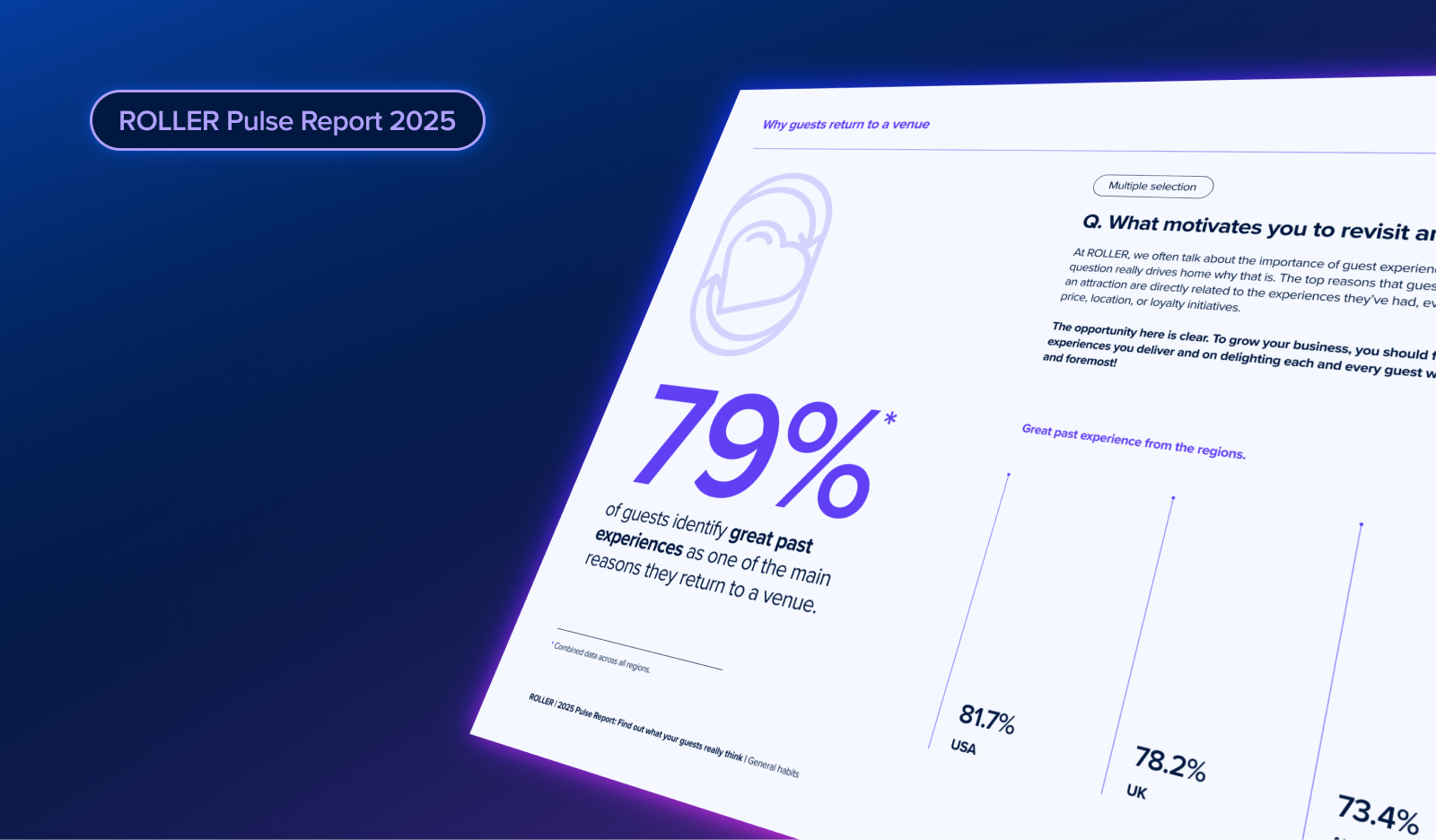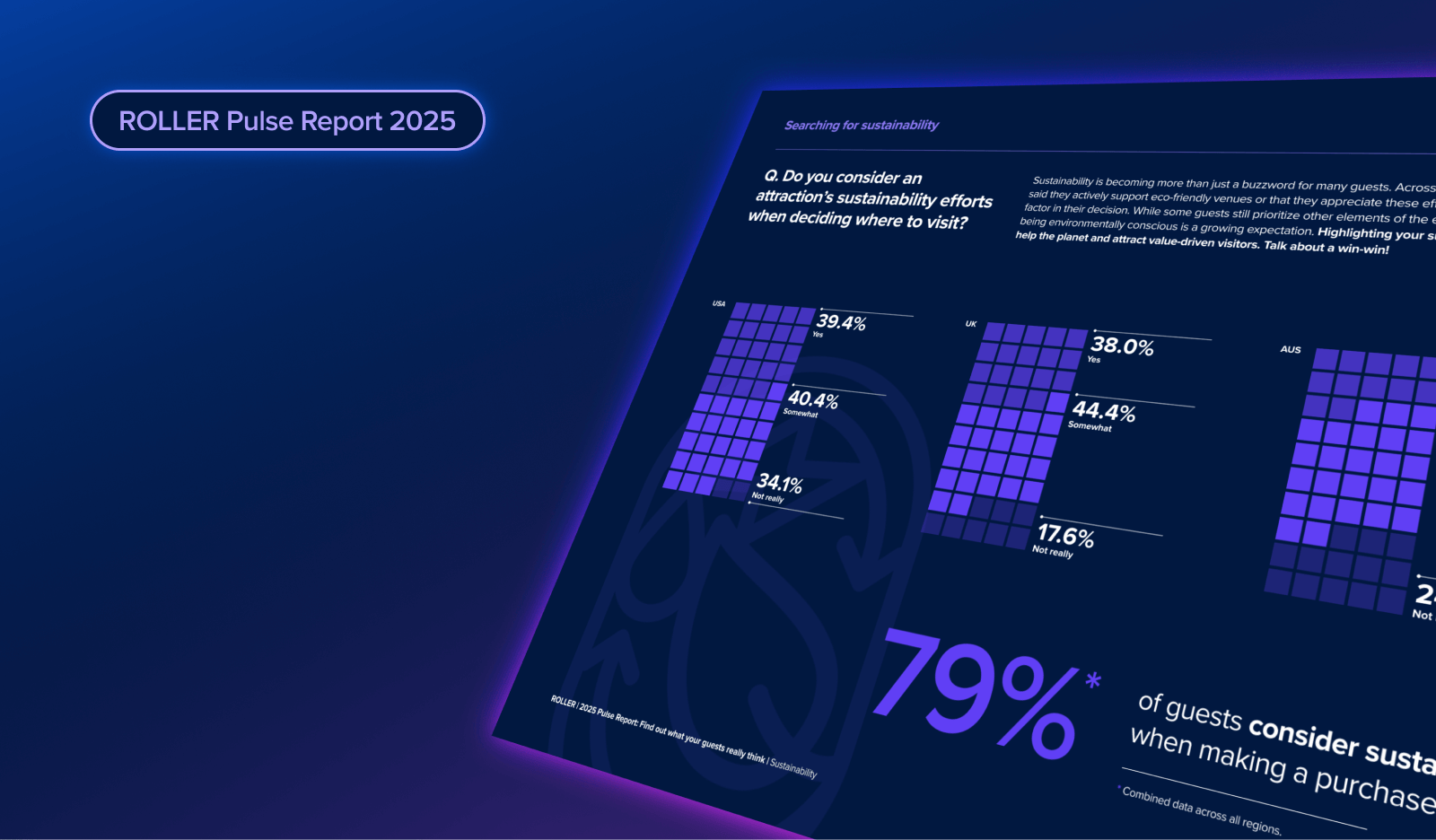Underutilization: Why It’s Bad and How To Fix It
.png?width=820&name=Underutilization%20in%20Attractions_Social(2_1).png)
The last thing any attraction venue owner wants to see are vast, silent spaces or staff members lingering with little to do. Sadly, this is a real challenge faced by many venues. It's the story of missed opportunities, of investments not fully realized, and of experiences that could have been magical, left untapped.
Below, we'll discuss the concept of underutilization in attractions, uncovering its impact, recognizing its signs, and exploring strategies to awaken the full potential of your venue, ensuring every day is as vibrant and lively as it deserves.
Key takeaways
- Underutilization signals missed revenue and satisfaction opportunities
- Spotting underutilization early is key to effective management
- Combat underutilization with strategic planning and technology
- Ongoing monitoring ensures continuous venue improvement
What is underutilization?
Underutilization occurs when resources at your venue, such as attractions, staff, or technology, are not fully employed to their maximum potential. This situation causes inefficiencies and missed opportunities, directly impacting your venue's operational effectiveness and profitability.
Imagine a roller coaster running half-full on a busy day or a state-of-the-art VR zone gathering dust due to lack of promotion. These are classic scenarios of underutilization, where the assets you've invested heavily in are not delivering the returns they're capable of.
Types of underutilization
- Physical space underutilization: This involves areas within your venue that are not being used effectively or are often left empty. It could be an event space that is rarely booked or certain attractions that see minimal foot traffic. The key is recognizing that every square foot of your venue has potential revenue-generating capability, and any space not contributing to this should be considered underutilized.
- Staff underutilization: Your employees are one of your most valuable resources. Staff underutilization can occur when team members are not engaged in productive work due to lack of training, inefficient scheduling, or not matching their skills with the right tasks. It's not just about having staff on the payroll; it's about leveraging their capabilities to enhance guest experiences and improve operational efficiency.
- Underutilization of digital assets: Your online presence, from your website to social media channels, is critical in attracting visitors. Underutilization here can mean failing to update your website with the latest information, not engaging with your audience on social media, or not using data analytics to understand customer behavior and preferences. These digital tools are designed to boost your visibility and appeal; not fully utilizing them means missing out on significant engagement and revenue opportunities.
Causes of underutilization
Several factors can lead to underutilization, often intertwined and feeding into one another:
- Seasonal variations: Many attractions experience peak and off-peak seasons. Failure to adapt to these changes or find ways to attract visitors during slower periods can lead to significant underutilization.
- Poor marketing: If potential guests don't know about your attractions or what makes them special, they're unlikely to visit. Ineffective marketing strategies can result in low awareness and interest, directly impacting your utilization rates.
- Inefficient operations: Operational inefficiencies, such as long wait times, can deter visitors from exploring all your venue has to offer. Streamlining operations ensures guests have the time and desire to experience everything at your establishment.
- Lack of customer engagement: Engaging with your customers through personalized experiences, feedback loops, and loyalty programs keeps them returning. A lack of such engagement strategies can result in a one-time visit, with no repeat business or word-of-mouth promotion, vital for sustained utilization.
Understanding underutilization is the first step toward addressing it. By recognizing the types and causes, you can develop strategies to optimize your resources, enhance guest experiences, and improve your bottom line.
How does underutilization hurt your business?
When your venue doesn't operate at its full potential, it doesn't just impact the bottom line; it ripples through every aspect of your operations, from financial health to customer perception and operational efficiency. By understanding the impacts of underutilization, attraction venue owners and operators can take proactive steps to mitigate these challenges, enhancing both their financial performance and visitors' experiences.
Financial impacts
Underutilization can significantly dent your revenue streams. Attractions, staff, and digital assets that aren't fully utilized don't just represent missed opportunities; they translate into direct financial losses. With fixed costs remaining constant, the relative cost per visitor or activity increases, making your business less profitable. This scenario underscores the importance of maximizing resource use to avoid wasted investments and ensure financial sustainability.
Brand and experience impact
The customer experience is at the heart of your business. When attractions are underutilized, guests aren't engaging as fully as they could, potentially due to a lack of awareness or appeal. This diminished engagement can lead to a poorer perception of your brand, affecting customer satisfaction and loyalty. Visitors who feel their lackluster experience are less likely to return or recommend your venue to others, hindering your ability to grow a loyal customer base.
Operational inefficiencies
Underutilization can also shine a spotlight on operational inefficiencies within your venue. Staffing imbalances become more apparent when employees are not utilized effectively, leading to overstaffing during slow periods or understaffing when it's unexpectedly busy. This can also lead to staff burnout or low morale, further increasing operational inefficiencies.
Additionally, maintenance issues or outdated technology may contribute to underusing certain areas or services, compounding inefficiencies. Addressing these issues is key to improving overall operational effectiveness and customer satisfaction.
Underutilization signs
Recognizing the signs of underutilization in your attraction venue is the first step toward turning things around. It's about identifying the gaps between potential and actual performance. Here, we'll explore common indicators of underutilization.
Low visitor numbers
One of the most obvious signs of underutilization is when visitor numbers consistently fall short of your venue's capacity or initial expectations. This gap indicates that your attraction is not reaching its full market potential. Whether due to seasonal fluctuations, ineffective marketing, or an unappealing offer, low visitor numbers clearly signal that it's time to reassess and strategize.
Idle resources
Resources, be they attractions, staff, or equipment, lying idle is another telltale sign. If you notice that certain areas of your venue are frequently unused or that staff members have too much downtime, you're facing underutilization. This leads to financial inefficiencies and demoralizes the team, as employees thrive on engagement and productivity.
Negative feedback
Listening to your customers is vital, which is why it's important to use tools such as automated guest experience surveys. Negative customer feedback is a red flag, especially if it points to a lack of engaging content, activities, or satisfactory staff interaction. Such feedback suggests that your venue may not fully meet visitor expectations or that certain experiences are underutilized or overlooked.
Operational metrics
Diving into operational metrics using a reporting tool can offer concrete evidence of underutilization. Key indicators include low occupancy rates, decreased spending per visitor, and underperformance during what should be peak periods. These metrics can help pinpoint specific areas of concern, allowing for targeted interventions.
How to prevent and manage underutilization
Keeping your venue lively all year round takes a mix of meticulous planning and creativity. To dodge the quiet days and ensure every corner of your venue is buzzing with energy, you'll need to weave together various strategies, from smart forecasting to fresh, engaging promotions. Here's a guide to striking the perfect balance, ensuring your venue is always the place to be:
Leveraging data analytics
Data analytics can be a powerful tool for uncovering trends and patterns that might not be immediately apparent. By analyzing visitor numbers, peak times, and usage rates of attractions, you can pinpoint exactly where underutilization is occurring. This data-driven approach allows for informed decision-making, enabling you to adjust operations, marketing, and staffing to better meet demand.
Utilizing customer surveys
Customer surveys serve as a direct line to your visitors' thoughts and feelings, offering invaluable insights into their satisfaction levels and pinpointing areas ripe for enhancement. Feedback on the visitor experience, from the appeal of attractions to the quality of staff interactions, can highlight aspects of your venue that are underperforming or underutilized. Engaging with your visitors like this aids in identifying issues and fosters a sense of inclusion among your customer base.
Conducting operational audits
Operational audits are like a health check-up for your venue. They allow you to dive into the nuts and bolts of how things run, from how staff are scheduled to how well maintenance is maintained. These detailed reviews are designed to uncover hiccups or slowdowns in your operations that might keep your attractions from being fully enjoyed. This careful attention to detail ensures that your venue isn’t just functioning but flourishing, creating memorable moments for your guests.
Strategic planning
The cornerstone of preventing underutilization is strategic planning. It’s about making smart, informed decisions that align your resources—attractions, staff, or technology—with anticipated demand. Using predictive analytics for forecasting and engaging in thorough capacity planning are crucial steps. This forward-looking approach allows you to anticipate fluctuations and prepare accordingly, ensuring that resources are optimized and ready to meet visitor needs.
Dynamic pricing and promotions
Dynamic pricing and targeted promotions are powerful tools for managing demand and enhancing utilization. Adjusting prices based on anticipated visitor numbers or using promotions to attract more guests during traditionally slow periods can smooth out demand and keep your venue bustling. You can even tailor the promotions to your audiences' interests by using a CRM. This strategy boosts revenue and ensures a steady flow of visitors, making every day a vibrant one at your venue.
Experience enhancement
Enhancing the visitor experience is key to increasing engagement, encouraging repeat visits, and generating positive word-of-mouth. This could involve anything from introducing new attractions to offering memberships. By continuously innovating and improving, you create compelling reasons for visitors to return and new guests to come explore.
Operational flexibility
Operational flexibility, such as cross-training staff and adaptable use of spaces and technology, allows you to respond swiftly to changing circumstances. This agility ensures that your venue can seamlessly adjust to varying levels of demand, providing a consistently high-quality visitor experience regardless of how busy or quiet the day is.
Leveraging technology
Digital tools and platforms like ROLLER can significantly optimize operations, from advanced booking systems that streamline visitor entry to self-service experiences that delight guests. These technologies enhance the visitor experience and improve operational efficiency, allowing you to offer something unique and engaging regardless of the season.
Community and collaboration
Building partnerships with local businesses, tourist boards, and community organizations can play a big role in driving traffic and optimizing use. These collaborations can lead to joint promotions, events, and packages that benefit all parties, creating a stronger, more vibrant tourist ecosystem.
Avoiding underutilization in your business
By proactively addressing underutilization, you can avoid the pitfalls of inefficiency and pave the way for future success. These strategies ensure that every aspect of your operation is fine-tuned to meet and surpass the expectations of your guests, creating memorable experiences that encourage repeat visits and positive word-of-mouth. Ultimately, this approach to managing underutilization safeguards your venue's financial health and enhances its reputation as a must-visit destination, promising a vibrant and engaging experience every day.
Find out how ROLLER can help your venue streamline operations.
Related articles

.png)
What the 2025 Pulse Report Reveals About Guest Booking Behavior at Attractions

2025 Pulse Report: How Sustainability Is Shaping Guest Expectations
Enhance your guest experience
Get free education, tips and inspiration to help you run a successful venue.